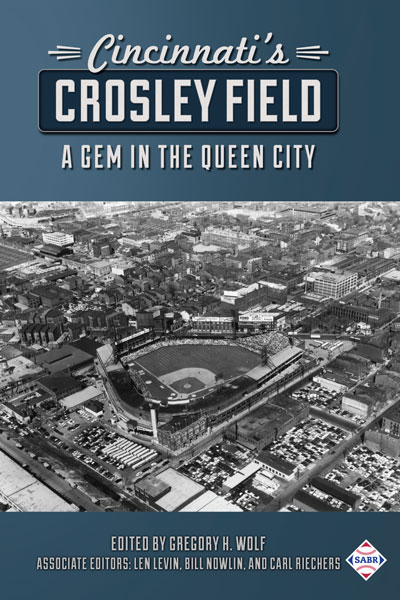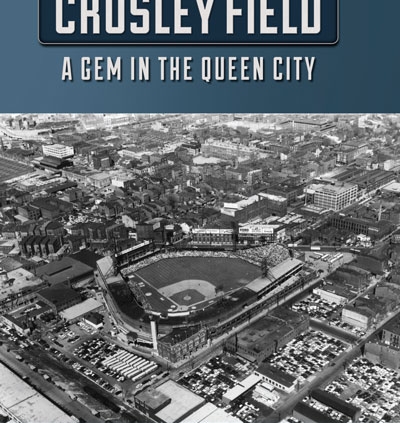Crosley Field and the 1937 Flood in the Queen City
This article was written by Greg Rhodes
This article was published in Crosley Field essays
 In the 1936-37 offseason, The Sporting News carried a series of articles on baseball’s groundskeepers. Among those featured was Matty Schwab, the longtime superintendent of Crosley Field.
In the 1936-37 offseason, The Sporting News carried a series of articles on baseball’s groundskeepers. Among those featured was Matty Schwab, the longtime superintendent of Crosley Field.
Reds baseball writer Tom Swope described how Schwab, respected as a “master groundskeeper” by his peers, carefully tended his field, including the elaborate system of drains Matty had installed beneath the Crosley turf. The “outfield is honey-combed with tile drains which carry off the surplus water at a surpisingly rapid rate of speed,” wrote Swope.1 The drains flowed into the nearby Millcreek, a few hundred yards to the west of Crosley Field.
By the time the story appeared on January 21, Matty’s drains were under siege as never before. Heavy rainfall had inundated the Ohio Valley and the Ohio River had already reached flood levels. By January 26 the river crested at 79 feet, far above any previous flood levels in Cincinnati, and hundreds of blocks of low-lying land in and around the city were covered in water. An estimated 100,000 people were homeless. And Matty’s plumbing had surrendered to the flood waters, which began invading Crosley Field.
In the early days of the deluge, Crosley filled up like a bathtub, as the drains backed up with overflow from the Millcreek. The surrounding streets were still dry. This backup was not an unusual event for Schwab. Just a year before, in 1936, after a minor flood, some six feet of water covered Crosley Field two weeks before the opener. Matty had all the slime and debris cleaned up by Opening Day.2
But this time, as the rain continued to fall and the Ohio River kept rising, the current surged up the Ohio tributaries, including the Millcreek. Water soon crept into the streets around the ballpark, rising high enough on Western Avenue, the eastern boundary of the park, that water flowed over the center-field wall.
That created the circumstances for one of the iconic photos of the 1937 flood, and in Crosley Field history, the photo of men in a skiff, navigating the pond that now covered the playing field and lower grandstands to a depth of 21 feet. This skiff was one of many boats that made their way into the ballpark, but this particular party included two Reds pitchers, Lee Grissom and Gene Schott, along with Schwab, and was reprinted in papers across the country. The Sporting News ran the photo on February 4.3 The photo captured both the scope of the flood, and the determination and spirit of Cincinnatians to make the best of a hopeless situation.
Were Grissom and Schott just on a sightseeing trip, an impromptu journey provoked by the novelty of it all, or was it more purposeful? According to local lore, which has no certain provenance, the excursion might be explained in pecuniary terms. One or both of the pitchers was being paid on an annual basis, and the paychecks were in the Crosley offices. And it was payday, flood or not.
About the same time the photo was taken, a series of cartoons appeared in the Cincinnati Enquirer suggesting how the Reds would adapt to the flooded conditions. Cartoonist Harold Russell imagined outfielder Ival Goodman patrolling right field in a skiff, shortstop Billy Myers scooping up balls with a net, and Kiki Cuyler stealing a base with a splashing, belly-flop slide.4 Another wag had chalked a note on a dry spot on the grandstand: “No Game Today – Wet Grounds.”5
The Reds did have more serious concerns. Although the water in the ballpark had little current, debris still floated over the fence and threatened to damage the structure. “We had from 10 to 40 men patrolling the field in rowboats night and day,” reported new general manager Warren Giles. “They kept dragging the floating oil drums, whiskey casks, auto tires, timbers, packing cases, etc. away from the stands and clubhouse before they could do damage.”6 Giles, in his first months as the Reds GM, said he had personally put in time on the rowboat patrol, a task not likely found in his new job description.
Not only did the Reds have to worry about flotsam entering the ballpark, they had to keep property from floating off. At one point, Schwab “was seen frantically rowing up the street chasing a ticket booth that was floating away. His rescue mission was successful.”7
At the baseball writers’ dinner in New York in early February, Giles received a fair amount of teasing about the condition of the ballpark. One writer referred to him as “Noah,” wondered if Giles would sign swimmer and Tarzan movie star Johnny Weissmuller to a contract, and if the Reds might switch to water polo for the 1937 season. But Giles promised that the grounds would be fine for Opening Day and there would be no disruption of the schedule.8 However the Reds did have to replace the visitors clubhouse, an antiquated structure that no one missed.9 Overall damage estimates ran about $30,000, over $500,000 in today’s dollars.
As Giles promised, the Reds held their annual festive opener as scheduled, featuring partly sunny skies and balmy spring temperatures. The only evidence of the flood was lines on the grandstand beams to mark the crest of the water and a mark on the center-field flag pole that was slightly higher than the top of the center-field wall.10
GREG RHODES, a former chair of the Hoyt-Allen SABR Chapter of Cincinnati, is currently the Cincinnati Reds team historian. He was the founding director of the Reds Hall of Fame and Museum and served as director from 2003-2007. Two of his eight baseball books received The Sporting News-SABR Research Award (Reds in Black and White, with co-author Mark Stang, in 1999 and Redleg Journal, with co-author John Snyder, in 2001), and his book Big Red Dynasty, with co-author John Erardi, was a finalist for the 1998 Seymour Medal.
Notes
1 Tom Swope, “Schwab Couldn’t ‘Make’ Majors as Pitcher,” The Sporting News, January 21, 1937: 5.
2 “Baseball,” Cincinnati Enquirer, January 31 1937: 2.
3 The Sporting News, February 4, 1937: 4.
4 Cincinnati Enquirer, January 30, 1937: 11.
5 “‘Wet Gounds’ at Crosley Field,” The Sporting News, February 4, 1937: 4.
6 “’Tisn’t So, Says Red President,” Cincinnati Enquirer, February 8, 1937: 11.
7 The Sporting News, February 4, 1937: 4.
8 “’Tisn’t So, Says Red President.”
9 The Sporting News, February 18, 1937: 11.
10 John Erardi and Greg Rhodes, Opening Day (Cincinnati: Road West Publishing, 2004), 226.


